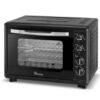
The Types of Whisks: Kitchen Essentials
Whisks are one of the most indispensable tools in any kitchen, used to mix ingredients, incorporate air, and create smooth, consistent mixtures. Whether baking, cooking, or preparing sauces, the right whisk can make a big difference in your results. There are several types of whisks, each serving a unique purpose.
In this guide, we will explore the different types of whisks, their uses, and how to choose the best one for your kitchen.
Balloon Whisk
The balloon whisk is the most common and multi-purpose whisk found in the kitchen. The large, rounded shape of the balloon whisk contains many thin, flexible wires that can incorporate air into mixtures at an incredible speed. It is ideal for aeration purposes: whipping cream, beating egg whites, and making meringues. The surface area is increased because of the shape, which will allow it to beat in the air much better and provide a light and fluffy texture.
Balloon whisks work well in mixtures that have a liquid foundation and require some lightening. However, with heavier mixtures, they are rather less than effective. The wires tend to bend under such pressure with heavy ingredients; for this reason, they are used mainly for mixtures that must remain light and airy.
Flat Whisk
Another indispensable tool in the kitchen is the flat whisk. The name itself says it all because it’s wide and flat, carrying several wires set in a horizontal pattern. Because of its flat shape, it reaches the edges of a pan, perfect for stirring sauces, gravies, and batters. It ensures smooth, consistent mixing and that none of the ingredients remain in lumps.
Flat whisks are perfect for stirring ingredients in shallow pans and when working on sauces and reductions. It allows more control, making it easier to avoid burning or sticking in delicate recipes. However, it may not be as effective for whipping air into mixtures as the balloon whisk.
French Whisk
The French whisk is the balloon whisk cousin, only elongated and tapered. This kind of whisk has fewer and thicker wires than its other cousin, with wires that are closer to each other. The French whisk is suited for thicker mixtures whether in batter or sauce; this model is considered quite versatile by most professional chefs because it can work quite well under extreme conditions.
The longer handle can be narrow in applications, which makes it ideal when making rouxes, stirring custards, and mixing pancake batter.
Unlike the balloon whisk, which is foremost used for aerating mixtures, the French whisk serves to mix mixtures in a smooth, easy manner. Due to its build, it creates a good balance between aeration and control; hence, it is very important both in professional and homemade cooking.
Whisk spiral
The spiral whisk has a single spiral design that works rather well in heavier mixtures, such as dough, very thick batters, and also heavy cream, where it will move around nicely while being whisked. So, this unique spiral shape allows mixing well with great force, it can take an amount of pressure with heavy ingredient loads without denting or discarding its wired shape, prevents ingredients from getting inside the wires, and also allows effortless cleaning.
Spiral whisks have thicker wire loops, which come in handy when a little more muscle is applied to mix heavier dough bread and thick sauces. Thus, they will work in heavy mixing, being more reliable, hence being used continuously in bakeries and kitchens dealing with thicker mixtures.
Egg Whisk
The whisk is small in size and light in weight, solely used for whisking eggs. It has a smaller size and thin wires, thus enabling rapid stirring of eggs for an omelet, scrambled eggs, or baking recipes. The egg whisk will work best in simple jobs that call for speed in mixing without overworking the food. This would especially come in handy while preparing egg-based dishes like custards or soufflés where precision and control are key.
Although the egg whisk is smaller compared to other types, it is very effective in mixing small portions of ingredients. Light in weight, it is easy to handle, even for beginners, and can be used for whisking eggs and other light tasks in the kitchen.
The Best Whisk for Your Kitchen
First of all, one needs to decide on a whisk that would perform a certain task easily. All whisk types are strong at something, so choosing the right whisk means the difference it makes in your cook or baking. Here’s how to choose:
Balloon whisks are good for light, airy mixtures like whipped cream and egg whites. Flat whisks work very nicely for stirring your sauces and gravies in relatively shallow pans. French whisks offer the advantage of control for thicker batters and sauces. Spiral whisks are best used in mixing dense dough and heavy mixtures. Egg whisks work well when it comes to whisking eggs or in small batches of mixtures.
Conclusion
Whisks are indispensable tools in the kitchen, and an understanding of whisk types will give you the appropriate whisk for whatever the job might be. For whipping cream, stirring sauces, or mixing dough, the right whisk will make a world of difference in perfecting the desired texture. With so many whisks for different purposes, it is definitely worth investing in a few to further your cooking and baking skills and make your time in the kitchen more enjoyable.



